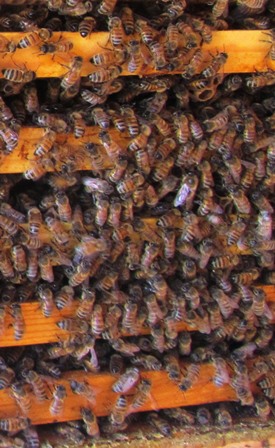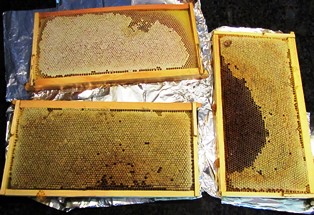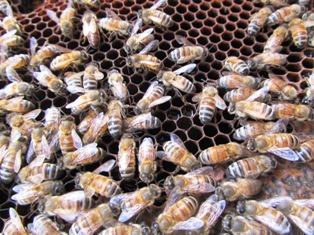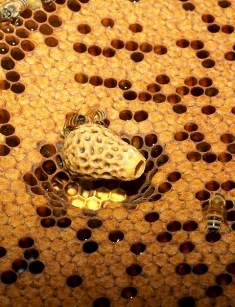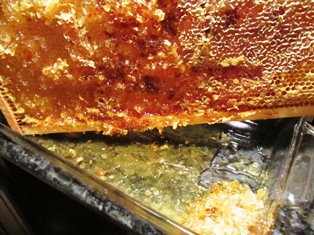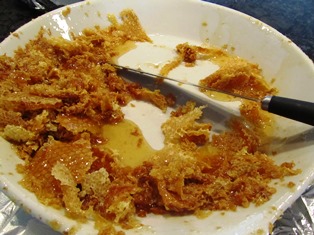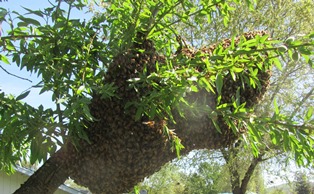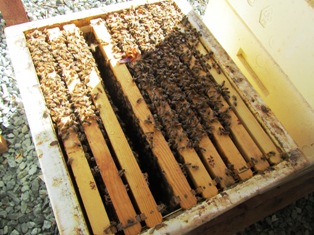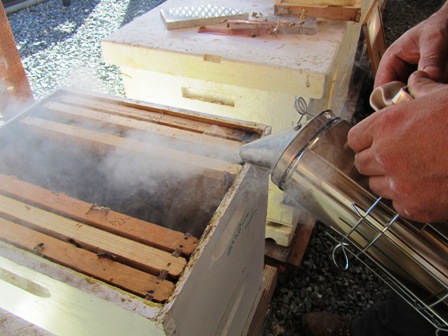Blog Archives
A False Swarm . . . Sort Of
When I heard my neighbors banging on a pan with a wooden spoon, I sprang into action. It is what we do when a honeybee hive swarms.
As it turned out, my bees had swooped from the hive with their queen into the front yard, past the plum tree and were circling above the blood orange. My neighbors, who were in their courtyard, saw it and began the banging to confuse the bees so they would alight close to their home.
I ran out and, with direction from my beekeeper neighbor, placed the hive near the orange tree. I’d already placed eight frames with wax and my neighbor brought over two with honey on the comb. All seemed to go as planned. We shook the tree and the bees dropped into the prepared hive.
My neighbor went home, and I went back to my computer and the novel I’m writing. Thirty minutes later, the bees were swarming again. I ran out and banged on the pan. They settled down. All seemed well, except for ants that had been in the orange tree and now were in the hive box.
Around nine o’clock at night, I sprayed the outside of the hive with Windex and wiped it with paper towels. I repeated the procedure around the perimeter of the box, replaced the lid, and carried the hive box back to the apiary believing all would be well. It wasn’t.
This morning, I ran out and suited up in my beekeeper’s outfit and gloves, opened the new hive box, and looked in. To my dismay, all the bees were gone.
My neighbor later told me over coffee that the bees had likely returned to their old hive as small swarms sometimes do. So . . . I suppose I may be repeating this whole scenario at some point in the days ahead. My neighbor reminded me that the weather has been strange, and the weather affects the bees’ behavior.
Sixty Pounds of Honey, Death of Some Drones, and a New Swarm
I opened my hives this past Sunday with the help of my world-class beekeeper neighbor. We checked on the the condition of eggs, the number of new queens, the growth of baby bees, the presence of mites (none detected), and the amount of honey (lots).
The male bees (the drones) over the last weeks have been engaged in some crazy flight patterns in front of the hive as the mating of the queen takes place. The old queen has done her egg laying and the hives have lots of babies with nurse maids and other worker bees. From the hives comes the clearly audible sound of humming and the fragrant scent of honey.
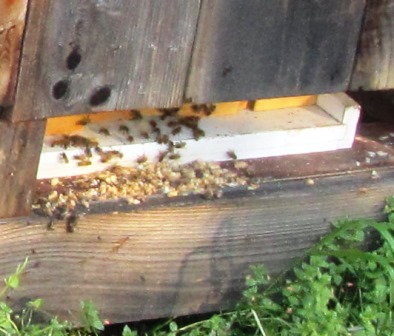
The drone (male bees) are vital for mating with the queen; after that, they are unnecessary and are eliminated
The drones are not now needed and the workers in the colony are doing away with them. I found a stack of drones at the front door of the hive this morning. Strange sight to see, indeed. But no more so than the many queen houses (formed from honeycomb by the worker bees). These houses are where the new queens are nourished; each contains royal jelly.
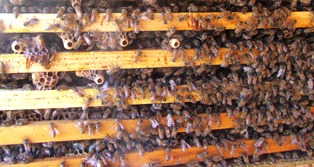
The tubular circles are the houses where the baby queens will be cared for by the workers. The houses contain royal jelly for the feeding of the new queens
My neighbor told me to wait three more weeks to take honey, but since I didn’t take any honey during the fall/winter and there were huge stores of it in my hives and coupled with the fact that there’s a plethora of flowers now to provide pollen for the bees, we decided it would be okay to remove some frames. So, I took six frames (weighing roughly ten pounds each) from the hives.
The honey I harvested has a pale lemony color–significant for the wildflowers and almond and fruit tree blossoms from which the bees collected the pollen to make that honey. In the fall, the honey is darker and earthier tasting, thanks to pollen from the star thistle and eucalyptus blooms.
When we had finished with my hives and walked back to my neighbor’s house, we spotted a swarm overhead. We grabbed the pots and wooden spoons and started banging. The bees took refuge in the tall pepper tree and that’s where my neighbor rescued them. In all, it was quite a spectacular Sunday!
Time to Open the Hives, Check on the Bees
My honeybees have become surprisingly active for the dead of winter. Local forecasters tell us that the Bay Area temperatures may reach 80 degrees Fahrenheit by the end of the week. My apple and early peaches won’t wait; they’ve already blossomed.
The warm weather, time of year together with the fact that almond trees will be blooming in a couple of weeks and the lavender around my farmette is already blooming tells me I have to open the hives. My beekeeper neighbor says that his bees are already out collecting pollen–lots of it–and that means we have to get to work.
The hives have to be checked now for mold (that long period of hard rain in December caused some of my neighbor’s frames to mold). Moldy frames can’t be renewed; they have to be tossed. Honeybees can get nosema (with diarrhea), which shows up as spots at the base of the hive.
The bees are finding flowers on their forage runs and are returning to the hive laden with pollen.
Bee queens will be busy laying eggs in the coming weeks, if they aren’t already. This is the time for beekeepers to purchase new queens. By the first week in April, it’s possible we could see swarming.
So here’s the plan. If the hives have a lot of honey, I’ll harvest some. Strange to be doing that in winter, but the hive will need space for brood. I’ll have to remove frames of honey and insert empty frames with wax (put in the freezer first for a period to kill any pest they might be harboring over).
I’ll put bee food patties in the open hives, so they’ll have plenty to eat (once I take some of their honey). My beekeeper neighbor tells me this will get the hive “heated up” for the queen to do what she does best–lay the eggs.
With so much activity, I’m confident that everything will turn out well, but you never know until you’ve inspected the interior of the hive and checked out everything, including the possibility of mold or the presence of pests or illness.
Mother Nature didn’t ask me, but I would have preferred she wait another month before removing her winter robes and dressing in spring florals. It just seems like now everything to do with the hives is on fast forward!
Harvesting Honey the Old-Fashioned Way
Last weekend, my beekeeper neighbor and I harvested three frames of honey from my hives. I took the frames into my house and, with a hot knife, cut open the wax cells to permit the honey to drain.
I drained off one-half gallon of honey from two frames.

Two frames drain simultaneously in a five-gallon bucket; another option is to use large, flat plastic tubs
I wrapped the extra frame in foil and froze it until I am ready to drain that frame as well. Then, I will let it thaw for 24 hours before draining off the honey.
Once all the honey is out of the frames, I take the frames outside and hang them in the tree near the hives. The honeybees will do the cleanup, foraging all the honey and leaving only clean wax that I can melt for candle- or soap-making projects.
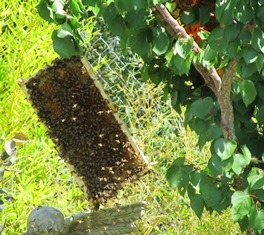
A frame of wax and residual honey is hung in a tree so the bees can clean it, hopefully before the ants find it
Draining honey from frames is a lengthy process and I have to do it twice: once to remove the honey and the second time to strain out any tiny particles of wax, before bottling it.
Last time, I took 20 frames and my neighbor, who was harvesting too, ran those 20 frames through his motorized extractor in his honey room.
Extractors are a modern convenience that saves untold hours extracting honey. But until I begin to sell my honey and other farm products, I won’t be able to afford such an energy-efficient tool.
I’ve discovered that beekeeping can be quite the expensive hobby. There are uncapping tubs, melters, comb cutting pans, heated knives, thermal plastic shrink bands for jars, uncapping needle rollers, and myriad other items used in honey extraction.
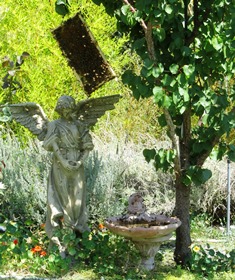
The tree near the hives holds two frames and a strainer of wax/honey from the uncapping of the cells that I also drained
Radial extractors can save time and preserves the honeycomb. The frames are placed between the guides of the stainless steel tank and the reel spins. The centrifugal force created throws honey against the sides of the tank. Honey is drained off through spigot. For now, the old-fashioned way works fine, too.
Streak of Warm Weather Starts Seasonal Bee Swarms
Last Wednesday heralded the official onset of spring. And it sure felt like it around the East Bay. The local beekeepers became more watchful as increasing bee traffic predicted an increased likelihood of swarms.
Last year, we rescued more than a dozen swarms from neighborhood trees as far away as two miles. Bees will fly up to five miles in search of food (they also need water), returning to their hives before darkness and the cool night air sets in.
Swarming is the way honeybees increase their numbers. The queen lays eggs throughout the winter and in spring, the hive will need more room to accommodate all the new offspring. Beekeepers can add “extensions,” but swarms will still happen.
The first swarm of the season found its way to my almond tree on the day before Easter. I had vigorously pruned the branches two years ago after discovering some limbs badly diseased. But the tree rebounded with hundreds of small, thin branches. The weight of the massive swarm caused the branch to give way. The bee swarm fell apart.
In less than a minute, the honeybees were again huddled around their queen on a thicker, stronger branch.
A styrofoam super with frames already inserted was placed under the branch. All it took was a couple of hard shakes of the limb to knock the bees in their new home.
The lid of the super was reattached and the box positioned so that the opening (the bees’ front door) faced the tree. The swarm would find safe haven inside the super as night approached.
After dusk, the super was turned from its western-facing direction to ensure that the bees’ front door faced east, the direction of the sunrise. Bees love the light and warmth of the sun.
Around the top of the super, some of the honeybees did a tail-waggle dance. My beekeeper neighbor told me it was their way of telling the other bees that this was their new home; to, “come on in.”
I guess those little fellows doing the waggle dance were the welcoming party.
The Seductive Taste and Smell of Honey
The sweet, seductive scent of honey permeates the rear of my property where the honeybee traffic has picked up now that we have had a few warm days. My neighbor Peter told me on Saturday that we would open the hives today. I enjoy helping him with bees, and my organic yogurt wouldn’t taste the same without that sweet honey drizzled on top.
Peter says it’s coming on winter now and the bees need food. Sources of pollen diminish during fall and winter. Our inspection will determine whether or not the bees and their hives are in good shape. Most likely, if there is honey, we won’t harvest it but rather leave it for the bees. Still . . . if there’s an abundance, we might take a frame or two.
When he was just a boy, Peter received his training as a beekeeper from his father. His father’s honeybees kept their Lebanese village supplied with honey. Our purpose in opening the hives today is to inspect the physical structures of the hives for mold, mites, ants, or any foul smell that might suggest a problem.
We last medicated the bees during the first week of October. This morning, the bees were so docile, Peter didn’t even suit up. But I did. Even so, the last time I put on the head-to-toe bee suit and the elbow length leather gloves, I still got stung as I was removing the suit.
At approximately 9:30 a.m. , we started to open the hives, smoking each one, in turn and closely checking each frame. The hives all looked healthy and robust. We removed spent containers of Apigard and the hanging sticks of antibiotic.
After inspecting each frame in each hive, we re-medicated the bees to ward off mites and anything that might attack or weaken the immune systems of the bees. The goal is to keep them healthy and strong so that the honeybees survive with their babies through the winter to swarm in the spring (swarms are the way the bees expand their populations).
The last three hives were particularly strong. The bees were busily working. Each super (styrofoam box or hive that holds ten frames) was heavy. We reduced the sizes of the hives to two supers instead of a stack of three on top of each other. Smaller hives during the winter means less work for the bees to stay warm and make babies.
Peter handed me three frames of honey to take to my kitchen. He also took a frame or two. Tomorrow, I’ll make a honey cake . . . if I can stop myself from constantly sampling the gorgeous colored, sweet tasting honey that slowly drips from the frames into large glass dishes in my kitchen.
 Facebook
Facebook Goodreads
Goodreads LinkedIn
LinkedIn Meera Lester
Meera Lester Twitter
Twitter




